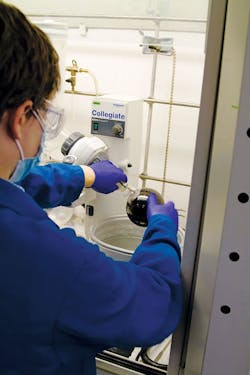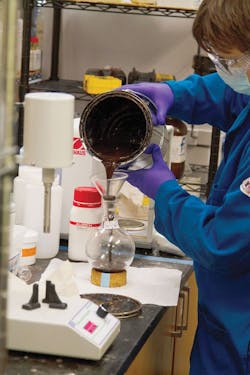Soybean oil-derived rejuvenator creates chemical reactions to restabilize RAP’s original SARA matrix
Recycling and the asphalt industry are virtually synonymous.
The first documented uses of recycled asphalt date back to the early 1900s. In the 1970s, two converging factors ushered in the modern era of producers using reclaimed asphalt pavement (RAP) as part of mix designs. First, the oil embargo that began in 1973 drove up the price of virgin binder, and then the first modern asphalt milling machine designs made it more efficient to collect and introduce RAP into mixes.
In 2008, when asphalt binder prices spiked above $700 per ton in some regions, there was another push to introduce more RAP into mix designs to lower costs. “Beyond price, asphalt producers have other motivating factors for running RAP in mix designs,” explained Dan Staebell, asphalt business development manager at Colorbiotics, the maker of a soybean oil-derived rejuvenator called Invigorate. “RAP utilization is also industry driven for sustainability, material optimization, and RAP inventory control.”
Less than a decade later, there would be an estimated 89.2 million tons of RAP used in mixes at over 1,000 plants within one calendar year, according to a 2019 survey conducted by the National Asphalt Pavement Association (NAPA) and Federal Highway Administration (FHWA). The average percentage of RAP used in asphalt mix designs had increased from 15.6% in 2009 to 21.1% in 2019. “When factoring in the cost benefits of binder and aggregate, 2019 RAP usage resulted in a savings of $2.3 billion,” said Joseph Shacat, director of sustainable pavements at NAPA.
From a sustainability perspective, the levels of RAP used in 2019 saved an estimated 4.5 million tons of asphalt binder and more than 84 million tons of aggregate, which is a testament to its environmental benefits. “The reduction in upstream greenhouse gas emissions from the amount of RAP used in 2019 was also equivalent to taking a half-million cars off the road,” said Shacat.
Asphalt pavements are engineered mixtures that require the right balance between component materials, as well as an understanding of the climatic and traffic needs of the community each pavement is supposed to serve. Always designing for long-lasting performance, producers must take a balanced approach to including RAP in mixes. “The binder in RAP is aged, brittle, and oxidized. So adding too much RAP without taking into account the overall balance of virgin aggregate, binder, and recycled materials may lead to premature road failure,” said Staebell.
Today, the asphalt industry has the necessary science and experience with RAP to deliver high-performance mixtures. “Rather than running test mixes and waiting 5-10 years to determine their performance, we now have the tools, tests, and chemistry to quickly offer insight on how the road is anticipated to perform,” said Staebell.
Meet SARA
The primary issue with introducing higher percentages of RAP to virgin aggregate and binder was the changed chemical structure of the recycled asphalt. “Oxidation significantly alters the SARA matrix of the asphalt binder,” said Austin Hohmann, engineer II at Iowa State University (ISU).
Asphalt binder consists of four components: saturates, aromatics, resins, and asphaltenes (SARA). The SARA scale ranges from the lightest molecule, which are saturates, to the heaviest molecule, which are asphaltenes. “Saturates are nearly clear liquids that float in between the heavier particles to lower the viscosity of the asphalt,” said Hohmann.
The lighter components of the SARA matrix are the first to be lost from the binder, according to Staebell, who explained that “a small percentage of the saturate naturally burn off during the asphalt mixing process.”
The oxidation that occurs throughout the aging process alters the SARA matrix to include a much higher percentage of the larger asphaltene molecules. What happens is the saturates, aromatics, and resins—also referred to as maltenes—fold in on one another as oxidation occurs, which causes the lighter molecules to fuse and create heavier molecules.
As the saturates, aromatics, and resins fuse to create asphaltenes, the asphalt becomes more and more brittle. When the asphalt becomes brittle, the road will no longer flex as designed, and energy dissipation will not be as efficient, which leads to lower performance in colder temperatures and a higher probability of cracking.
Maltene-rich injection limitations
Changes in the SARA matrix ultimately impacts the overall performance grade of the liquid asphalt binder. That means producers must account for the increase in asphaltenes, as well as the negative effect on low-end temperature cracking performance, when developing mix designs.
Mix designs with higher RAP percentages have also been noticeably less workable in the field. “The mixture is stiffer. That makes handwork more difficult and increases the difficulty for the rollers to meet spec densities,” said Staebell.
To ensure the road will perform over time, state agencies usually cap the percentage of RAP used in the mix or the amount of virgin binder replaced by the binder in RAP. The maximum permissible amount of RAP generally varies by job type, with mainline and highway paving being more restrictive, and commercial and county road designs often being more accommodating. The amount can also vary from state to state, and even city to city, but a common threshold is approximately 25% or less.
To move beyond that limit, the industry has experimented with recycling agents that are supposed to bump the binder to a softer grade, and also experimented with rejuvenators that are supposed to address the embrittlement issues posed by high-percentage RAP mixes. The downsides to recycling agents, in particular, have traditionally been cost and availability.
As an alternative to bumping the grade of the binder, most current rejuvenators work by injecting lighter maltene-rich material—saturates, aromatics, and resins—into the RAP binder that has become rich in the heavy asphaltenes due to oxidation. “These rejuvenators use the middle molecular weight. It’s like taking something that is heavy and something that is light, and the average weight is something in the middle, creating something that is ‘soft’,” said Chris Williams, ISU professor of Civil Engineering.
The problem is that attempting to balance out the heavy molecules in RAP by injecting lighter material only superficially changes the viscosity of the material. The asphalt might flow better and handle better than high-percentage RAP mixes without a rejuvenator, but the rejuvenator most likely will not deliver long-term performance in lower temperatures.
“To be completely effective, a rejuvenator should chemically react with the agglomerated asphaltene molecules to reorder and restructure RAP’s SARA matrix to its original composition,” said Hohmann. “Without addressing asphaltene agglomeration, there is just warm, brittle asphalt around virgin binder, which can impair crack resistance of the mix.”
Without a balanced SARA matrix, a high-percentage RAP mix will revert to its lowest energy. For instance, injecting lighter maltene-rich material into asphalt removed from a road that showed block cracking will not address the old issue in the new mix. The pavement could look good going down, but within 5-10 years, the block cracking will show up again. “A mix needs the proper percentage of SARA matrix for optimal high- and low-temperature performance. If this is not addressed, it’s just kicking the can down the road,” said Hohmann.
Bio-based chemical reaction
Engineers at ISU have developed a new generation of rejuvenator that addresses asphaltene agglomeration in RAP. This kind of rejuvenator creates chemical reactions at the molecular level to reestablish the SARA matrix of virgin binder. It is also a bio-based solution, rather than petroleum-based, that can advance sustainability and environmental needs around the industry.
The breakthrough started out as a collaborative effort between the United Soybean Board and ISU researchers to see how the triglycerides inside soybean oil modified the chemical structure of asphalt. Soybean oil consists of a few different oleic acids—alpha-linolenic, linoleic, and monounsaturated oleic—and the team’s hypothesis was that these base molecules, in the right formation, would work as a different type of rejuvenator that could positively impact the performance of RAP.
ISU engineers conducted lab trials focusing on low-grade recycled asphalt to analyze SARA matrix interactions when introduced to different formulations of the soybean oil-derived rejuvenator. Before and after samples of low-grade RAP with PG 52-34 binder were studied at the molecular level to see if the SARA matrix had been fractured.
RAP treated with the soybean oil-derived rejuvenator did indeed decrease asphaltene composition. “We saw a change in composition, particle size, and structure,” said Hohmann. High-level neutron testing offered indisputable evidence of a 30% reduction in asphaltene diameter. “This changes how the rejuvenator blends with RAP in a more beneficial way for the final product,” added Staebell.
Those findings should pave the way for economical use of higher RAP percentages in asphalt mixes, without negatively impacting the performance grade of the binder, because rejuvenated RAP binder can now offer similar performance characteristics to virgin binder. “Feedback from paving crews is that high-percentage RAP mixes using the rejuvenator have the workability and visible shine of the standard mix, and it can easily be compacted to spec densities,” said Staebell. “Plus, workers say it doesn’t have the chemical smell of traditional petroleum-based rejuvenators.”
The renewable rejuvenator can be blended with virgin binder at the terminal or injected in the asphalt cement line without modification to the existing plant design. The viscosity of the rejuvenator also allows it to flow in colder temperatures.
Staebell described the rejuvenator as any other type of plug-in product, such as warm-mix asphalt or an anti-stripping agent.
“This new generation rejuvenator fills a void in the market for a truly renewable chemistry that allows producers to run higher percentages of RAP in their mixes,” he said. “The bio-based rejuvenator addresses the durability issue of running RAP percentages as high as 50% by effectively breaking down asphaltene agglomeration in oxidized RAP, giving the industry an effective option for lowering costs, while improving sustainability efforts.”




